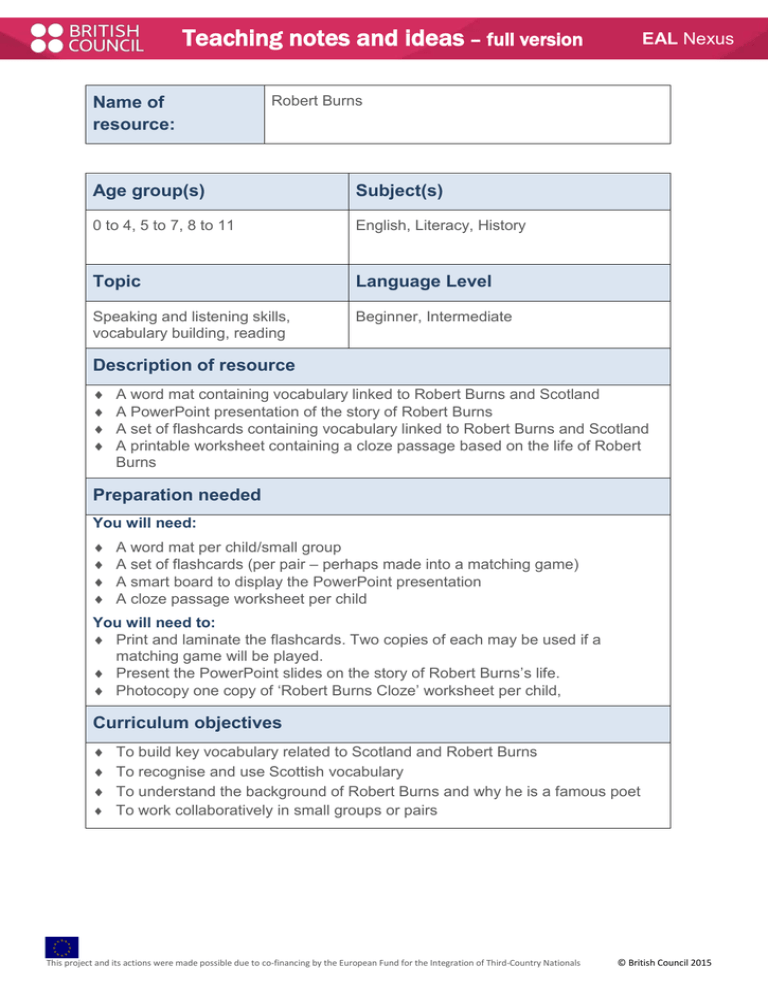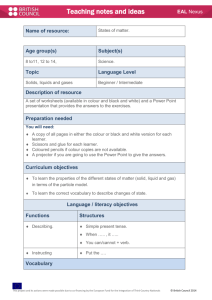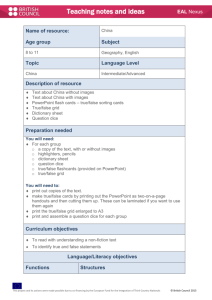Extended version - EAL Nexus
advertisement

Teaching notes and ideas – full version Name of resource: EAL Nexus Robert Burns Age group(s) Subject(s) 0 to 4, 5 to 7, 8 to 11 English, Literacy, History Topic Language Level Speaking and listening skills, vocabulary building, reading Beginner, Intermediate Description of resource A word mat containing vocabulary linked to Robert Burns and Scotland A PowerPoint presentation of the story of Robert Burns A set of flashcards containing vocabulary linked to Robert Burns and Scotland A printable worksheet containing a cloze passage based on the life of Robert Burns Preparation needed You will need: A word mat per child/small group A set of flashcards (per pair – perhaps made into a matching game) A smart board to display the PowerPoint presentation A cloze passage worksheet per child You will need to: Print and laminate the flashcards. Two copies of each may be used if a matching game will be played. Present the PowerPoint slides on the story of Robert Burns’s life. Photocopy one copy of ‘Robert Burns Cloze’ worksheet per child, Curriculum objectives To build key vocabulary related to Scotland and Robert Burns To recognise and use Scottish vocabulary To understand the background of Robert Burns and why he is a famous poet To work collaboratively in small groups or pairs This project and its actions were made possible due to co-financing by the European Fund for the Integration of Third-Country Nationals © British Council 2015 EAL Nexus Language/Literacy objectives Functions Structures Naming It is … , S/he is … , They are … Retelling He was … , He did … He was born… , He worked … Summarising He is famous because … Vocabulary Vocabulary naming Scottish items: Scotland, saltire, poetry, Robert Burns, writer, Scottish dancing, bagpipes, whisky, haggis, kilt Turn-taking vocabulary: you’re next, it’s your turn, etc. This resource could be used: whole class as differentiation within class one to one or small group Ideas for using the resource What to do Before reviewing the PowerPoint presentation the word mat can be used to introduce new vocabulary. This will prepare the children for the new words and visuals they will use related to Robert Burns and Scotland. The learners can then keep the word mat in front of them as an aid with the following activities. The matching games are useful visuals to help the learners become used to the vocabulary. The games should be reproduced for small groups (2–4 learners). Allow time for exploratory talk when playing the games. The learners should be encouraged to name the Scottish items when turning the cards over. More able learners should match the pictures to the word cards. The PowerPoint presentation will allow the learners to carry out some reading for meaning, in order to explore the topic of Robert Burns in some depth. The presentation could be used with a whole class or smaller groups. The presentation also uses key visuals to aid understanding of the story. The cloze passage is a DARTs activity using a modified text. The information is presented in a gap-filling activity. This will allow the learners to review and This project and its actions were made possible due to co-financing by the European Fund for the Integration of Third-Country Nationals © British Council 2015 EAL Nexus recall information they have covered in the PowerPoint. The learners could complete this activity as an individual task or as a collaborative activity. This would give them the opportunity to discuss the possible answers. Discussions between learners could also take place using learners’ L1 abilities if those with similar home languages are working together. Other ideas for making the best use of this resource The word mat could be used as a writing tool to write a short passage about Scotland. Learners could be asked to retell or rewrite the story of Robert Burns in their own words. The matching cards could also be used as flashcards. The matching cards could also be used for snap games. Opportunity could be given to learners to speak about the activities in first language. Possible extension activities An opportunity to hold and look at real items linked to Scotland such as a kilt, saltire, etc. would allow learners to extend their learning. A Robert Burns poem could be explored. The learners could research other famous Scots. Learners could discuss famous people from their home countries or symbols which are linked to their home countries. This project and its actions were made possible due to co-financing by the European Fund for the Integration of Third-Country Nationals © British Council 2015







